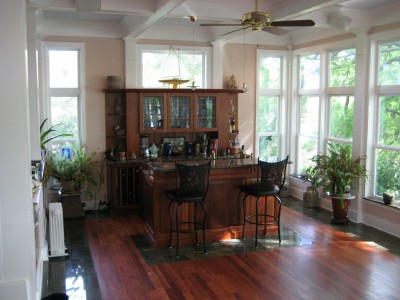



The idea for this blog post sprang from my discussion with Milton in the comments section of The Woodland House. On a certain level it’s true – most owner-built houses and alternative homes are not built as quickly and as “efficiently” as contractor-built homes. But then again, not everyone wants to live in lifeless tract houses that all look the same, fall apart rapidly, waste huge amounts of energy, require 30-year mortgages and poison the inhabitants.
What I am describing here is not really a housing style as some might imagine (Craftsman style, for instance), but rather the product of skilled builders who went to great lengths to create unique, high quality homes. There have always been craftsmen who take a different approach to mainstream production building – the “road less traveled” – and build solid, beautiful homes designed to last generations. Look around a bit and you’ll find homes like this across America and elsewhere. Look on side streets of older, quiet, good neighborhoods and you’ll find the handiwork of these craftsmen. Once you know what to look for, homes like this are not difficult to spot. The homes all have a unique, one-of-a-kind look that comes from being skillfully hand-built one at a time. Often the builders used local materials such as stone, timbers, wood shingles, and durable materials such as brick and tile roofing. The number one characteristic is workmanship. The builders obviously took pride in their work and it shows.
Many times master craftsmen built the homes for themselves, and the refined look shows a lot of thought went into the design. More specifically, the houses are often compact, have wood floors, lots of built-in storage, box beam ceilings, distinctive rooflines, custom trim, nice fireplaces and yards, and other details that set them apart from production homes. The end result is the complete opposite of contractor-built homes.
Production builders focus on maximum speed and profit – enclosing the most space, in the shortest amount of time, at the least cost. Most contractors love inferior products such as fiberboard, particle board, plastic, asphalt shingles, toxic glue, synthetic carpets, sheetrock and so on “to save money.” That’s why they burn like crazy and offgas toxic fumes. The final result of this rather insane mentality, where profits rule over humans and the environment, are sprawling, ugly suburbs. Where Would You Rather Live?
Image source: Flickrfanstan
Image source: Clark County Washington – John Roffler House
Image source: Real Estate in France.com
Image source: Premier Contracting
